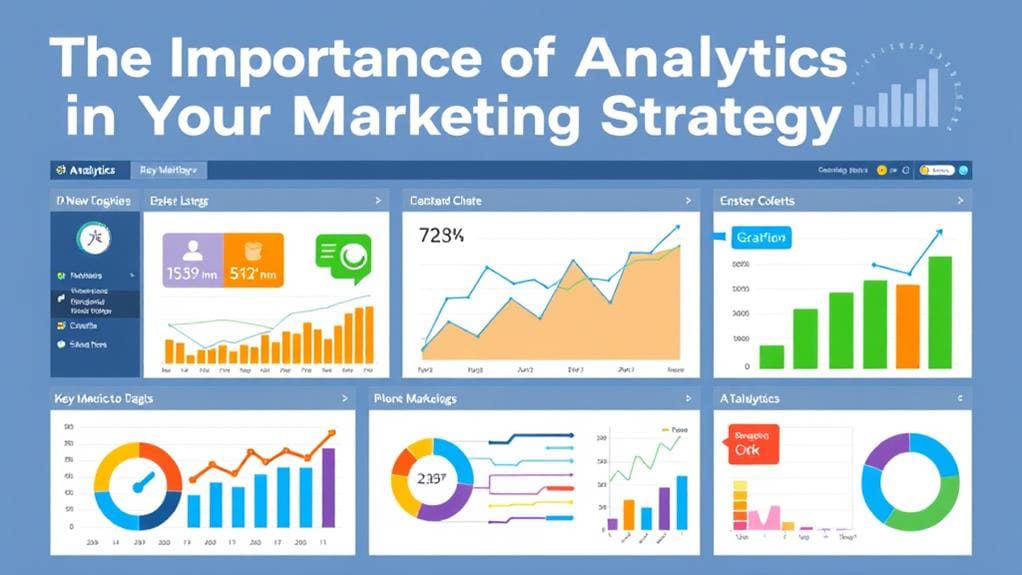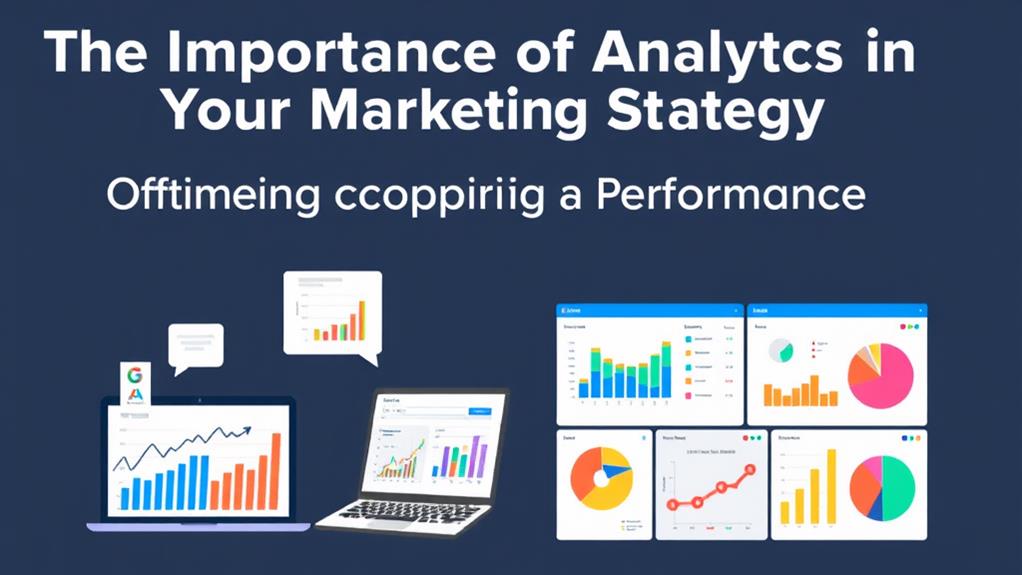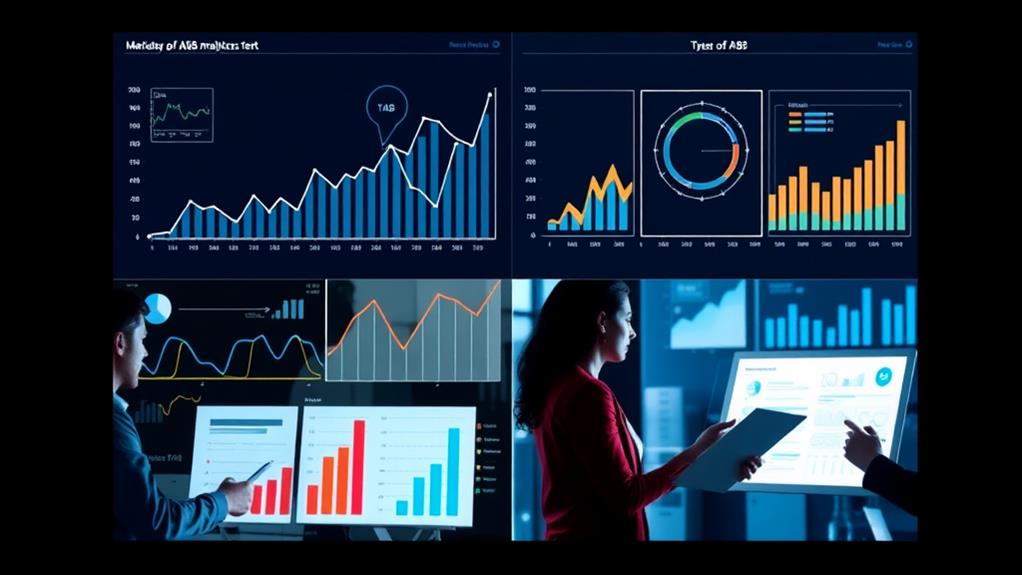The Importance of Analytics in Your Marketing Strategy
Analytics is essential for developing a successful marketing strategy by transforming raw data into actionable insights. It aids in understanding customer behavior, enabling precise segmentation and targeted campaigns that enhance conversion rates. By tracking key metrics, organizations can allocate resources efficiently and improve return on investment. Tools for data analysis, such as predictive analytics and A/B testing, refine strategies and optimize campaign performance. Additionally, analytics supports risk management by identifying potential pitfalls early. Using analytics responsibly fosters customer trust and drives sustainable growth. Discover how to leverage these insights for your strategy's success.
Key Takeaways
- Marketing analytics enhances decision-making by providing valuable insights into customer engagement and brand positioning.
- Data-driven decisions improve resource allocation and maximize marketing ROI through better understanding of audience segments.
- Key metrics, like conversion rates and customer retention, provide critical insights into campaign effectiveness and consumer behavior.
- Predictive analytics helps anticipate future trends, allowing for proactive strategy adjustments to meet changing market demands.
- Ethical data practices and compliance, like GDPR, build customer trust while facilitating innovation in marketing strategies.
Understanding Marketing Analytics

Understanding Marketing Analytics is essential for businesses aiming to optimize their marketing strategies and improve return on investment (ROI). Marketing analytics involves the systematic analysis of data to enhance decision-making processes related to customer engagement and brand positioning. A critical component of this process is customer segmentation, wherein businesses categorize their customer base into distinct groups based on demographics, purchasing behavior, and preferences. This segmentation allows for the creation of targeted marketing campaigns that resonate with specific audiences, ultimately driving higher conversion rates.
However, as companies collect and analyze vast amounts of customer data, they must navigate the complexities of data privacy. Guaranteeing that customer information is managed responsibly is paramount. Compliance with regulations such as the General Data Protection Regulation (GDPR) underlines the importance of maintaining transparency in data collection and usage practices. Businesses must prioritize secure data handling to foster customer trust while simultaneously leveraging insights drawn from analytics.
Furthermore, marketing analytics provides valuable metrics that indicate the effectiveness of various channels, whether online or offline. By examining key performance indicators, organizations can assess which strategies yield the best ROI and optimize their marketing budgets accordingly.
In an era defined by data-driven decision-making, understanding marketing analytics equips firms with the tools necessary to refine their approaches. Balancing innovative marketing strategies with ethical data practices ensures sustainable growth while respecting customer privacy—an essential consideration in today's consumer landscape.
Benefits of Data-Driven Decisions
Utilizing data-driven decisions greatly enhances a company's ability to make informed strategic choices. By leveraging data accuracy, organizations can guarantee that their insights are reliable, which directly influences decision speed and quality. This speed is vital for rapidly adapting to market conditions, allowing businesses to seize opportunities as they arise.
Additionally, data enables precise resource allocation, guaranteeing that marketing efforts and budgets are directed towards the most effective channels, thereby maximizing ROI.
Incorporating data-driven insights fosters effective risk management by identifying potential pitfalls before they escalate. With robust data analytics, companies can perform effective customer segmentation, allowing for targeted marketing strategies that resonate with specific demographics. This level of granularity enhances strategy alignment across departments, guaranteeing that all segments of the organization are working towards common goals.
In addition, accurate market forecasting rooted in data enables businesses to identify trends and emerging market shifts ahead of their competitors. This proactive approach leads to stronger performance evaluation methods, allowing for the continuous refinement of tactics.
Ultimately, an emphasis on data-driven decisions results in a significant competitive advantage, as companies become more agile and informed.
Key Metrics to Track

Tracking key metrics is fundamental for evaluating the effectiveness of marketing strategies and making informed adjustments. Key performance indicators (KPIs) provide invaluable insights that can drive success in various aspects of marketing.
Conversion rates are foundational metrics, quantifying how many visitors complete desired actions within the sales funnel. By analyzing these rates alongside audience demographics, marketers can fine-tune customer segmentation strategies to target the right individuals effectively.
Understanding channel performance is essential, as it reveals where marketing efforts yield the best return on investment (ROI) and guarantees that resources are allocated efficiently.
Lead generation is another important metric, reflecting the effectiveness of campaigns in attracting potential customers. High rates of lead generation can correlate with brand awareness, showcasing how well a brand resonates with its audience.
Tracking customer retention metrics also provides insights into existing customer loyalty and satisfaction—the longer customers stay engaged, the more favorable the ROI becomes.
Furthermore, marketing attribution techniques shed light on which channels contribute most notably to conversions, allowing marketers to optimize strategies accordingly.
Tools for Effective Analysis
Effective analysis in marketing requires leveraging the right tools to visualize data and accurately track key metrics.
Data visualization tools, such as Tableau and Google Data Studio, facilitate intuitive interpretations of complex datasets, enabling marketers to identify trends and patterns swiftly.
Additionally, robust tracking systems guarantee that metrics are captured reliably, providing a foundation for data-driven decision-making.
Data Visualization Tools
In the field of marketing strategy, choosing the right data visualization tools is vital for transforming raw data into actionable insights. Effective data storytelling relies on effective visualization techniques that enhance understanding and drive decision-making.
Tools that focus on dashboard design allow marketers to create all-encompassing views of key performance indicators, fostering quick assessments of performance trends.
The use of interactive graphics promotes audience engagement, enabling stakeholders to explore data dynamically and derive insights that resonate with their specific interests.
Additionally, infographic creation has emerged as a powerful method to distill complex information into digestible visuals, enhancing retention and clarity.
Selecting the appropriate chart types is essential for accurately representing data relationships and trends, while maintaining data aesthetics guarantees that visuals are not only functional but also appealing.
Software comparison among various tools can provide marketers with options tailored to their needs, particularly where design principles converge with usability.
Ultimately, investing in robust data visualization tools elevates analytical capabilities, leading to informed marketing strategies that resonate with targeted audiences.
Tracking and Metrics
Measurement is the foundation of a successful marketing strategy, as it provides insights into campaign performance and audience engagement. Effective tracking techniques allow marketers to harness data accuracy, ensuring that actions are informed and responsive.
The initial step involves metric selection tailored to specific objectives—aligning key performance indicators (KPIs) with overarching business goals enhances relevance.
Report automation plays a critical role, enabling the regular analysis of trends, while performance benchmarks provide targets for ongoing improvement. Historical comparisons further enrich analysis, revealing changes in user behavior over time and assisting in strategic adjustments.
User segmentation is essential—it allows for differentiated targeting, maximizing campaign relevance and effectiveness. However, analytics training is crucial to empower marketing teams to utilize these tools effectively, fostering a data-driven culture.
While leveraging tracking and metrics, marketers must remain vigilant regarding data privacy, ensuring compliance and maintaining consumer trust.
Interpreting Data Insights

Understanding data insights is essential for tailoring marketing strategies that resonate with target audiences. The process of data interpretation begins with insight extraction, where raw data is transformed into meaningful information through context analysis. By examining data correlations, marketers can identify trends that inform decision-making frameworks, leading to strategies grounded in empirical evidence rather than assumptions.
Effective narrative building is critical in the area of performance storytelling. It allows for conveying the significance of data trends to stakeholders in a compelling manner. Through actionable insights derived from precise analysis, marketers can craft messages that resonate on an emotional and logical level, thereby enhancing engagement rates.
Audience segmentation plays a pivotal role in this interpretive process. By categorizing consumers based on behaviors and preferences, marketers can effectively tailor their strategies to meet the specific needs of different segments. This not only boosts relevance but also guarantees that resources are allocated efficiently.
The identification of trends enhances the predictive capacity of marketing initiatives, allowing organizations to stay ahead of the competition. Analyzing past performance and correlating it with current market conditions enables businesses to anticipate customer needs and adapt swiftly.
Ultimately, interpreting data insights equips marketers with the tools to drive successful campaigns and cultivate long-lasting relationships with their audience. By embracing a data-centric approach, businesses can foster innovation and achieve sustainable growth in an increasingly dynamic marketplace.
Leveraging Customer Behavior
Leveraging customer behavior is critical in shaping effective marketing strategies.
By understanding purchase patterns, analyzing engagement metrics, and predicting future trends, marketers can create targeted campaigns that resonate with their audience.
This data-driven approach not only enhances customer satisfaction but also improves overall business performance.
Understanding Purchase Patterns
Consumer behavior, a fundamental element in marketing analytics, reveals intricate purchase patterns that inform strategic decision-making. By utilizing purchase behavior analysis, businesses can implement effective customer segmentation strategies that cater to diverse market needs.
Analyzing seasonal buying trends allows marketers to anticipate demand fluctuations, thereby optimizing inventory and promotional efforts.
Understanding the impacts of loyalty programs is essential as they greatly influence buying behavior and can effectively reduce cart abandonment rates. Identifying cart abandonment reasons, such as website navigation issues or high shipping costs, enables marketers to tailor solutions that enhance the purchasing journey.
Demographic influences also play an important role in shaping online shopping habits. Age, income, and geographical location can drive product preference shifts, allowing marketers to refine their targeting strategies.
By recognizing these patterns, brands can create personalized experiences that resonate with their audience. Incorporating insights from these analyses not only empowers businesses to meet consumer expectations but ultimately fosters loyalty and increases sales.
Harnessing the power of analytics in understanding purchase patterns cultivates an agile marketing approach that adapts to evolving consumer demands.
Analyzing Engagement Metrics
Engagement metrics serve as essential indicators of how effectively brands connect with their audience. By analyzing these metrics, companies can establish engagement benchmarks that reflect their performance across various platforms. This granular assessment begins with audience segmentation, which enables brands to tailor their messaging and content performance based on users' preferences and behaviors.
Key social metrics, such as likes, shares, and comments, provide insight into interaction trends that inform engagement strategies. Further, analyzing conversion rates alongside user feedback reveals the effectiveness of certain channels, helping brands understand where to allocate resources for maximum impact.
Demographic analysis complements this by revealing specific audience characteristics, allowing for more targeted campaigns that resonate on a personal level. Additionally, businesses must adapt their engagement strategies to reflect both quantitative data and qualitative insights derived from user feedback.
Ultimately, harnessing engagement metrics is vital for optimizing channel effectiveness and ensuring that marketing efforts align with consumer desires. Brands that adopt a data-driven approach to analyzing engagement metrics position themselves to foster deeper connections with their audience, driving sustained growth and loyalty in an increasingly competitive landscape.
Predicting Future Trends
Predicting future trends in marketing requires a deep understanding of customer behavior patterns and how these patterns evolve over time. Trend forecasting plays a pivotal role in this process, enabling marketers to anticipate shifts in consumer preferences and adapt strategies accordingly.
By analyzing historical data and current consumer behavior, businesses can identify significant trends that indicate potential future directions.
Utilizing advanced analytics tools, organizations can collect and interpret vast amounts of data, allowing for a granular understanding of consumer behavior. This includes not only what customers are purchasing but also when and how they engage with brands across various platforms. Such insights are invaluable, as they inform decision-making and facilitate the development of tailored marketing campaigns.
Moreover, leveraging predictive analytics models enables marketers to simulate potential outcomes based on different scenarios, thereby refining their approach. In a landscape where consumer desires constantly evolve, harnessing this analytical capability fuels informed strategies that align with customers' aspirations for freedom and choice.
Ultimately, by committing to robust trend forecasting and understanding consumer behavior, businesses position themselves to proactively meet market demands, building stronger relationships and driving sustained growth.
Optimizing Campaign Performance

Effective optimization of campaign performance relies on a systematic analysis of key metrics and data-driven insights. To maximize efficacy, businesses must adopt robust campaign segmentation strategies that allow them to distinguish between different audience segments.
By employing advanced audience targeting techniques, brands can reach the individuals most likely to convert, enhancing overall campaign impact.
Incorporating creative optimization tactics is crucial; this involves constantly testing and refining messaging to find the most engaging content. Additionally, effective budget allocation methods must be utilized to guarantee that resources are directed towards high-performing channels.
Cross-channel integration is essential, as a unified approach can bolster message consistency while enhancing audience engagement across platforms.
Adopting performance benchmarking approaches enables marketers to measure their success against industry standards, while seasonal trend analysis helps to identify and leverage ideal times for campaign activation.
Through message personalization strategies, brands can create tailored experiences that resonate with their consumers, driving higher conversion rates.
Understanding competitor analysis insights allows marketers to refine their strategies by recognizing what works and what doesn't within their marketplace.
Finally, conversion funnel optimization is critical; by analyzing each stage of the customer journey, marketers can pinpoint drop-off points and guarantee a smoother progression toward conversion.
Each of these components plays a pivotal role in the continuous refinement of campaign performance, offering a pathway to measurable freedom in achieving marketing objectives.
Setting Measurable Goals
While establishing a marketing strategy, setting measurable goals is essential for driving accountability and ensuring alignment across initiatives. Measurable goals provide a concrete framework for evaluating performance and guide decision-making processes. Without these, teams may work in silos, diluting their overall impact and resulting in inefficient resource allocation.
To facilitate goal alignment, organizations must employ the SMART criteria—specific, measurable, achievable, relevant, and time-bound—when formulating objectives. This approach prevents ambiguity and fosters clarity regarding marketing aspirations. For example, a goal like "increase website traffic by 20% over the next quarter" is not only specific but also measurable against defined performance benchmarks.
Establishing performance benchmarks is vital for tracking progress and determining the effectiveness of various marketing initiatives. They allow teams to understand the baseline metrics and adjust strategies in real-time. Such data-driven insights empower marketers to pivot effectively, ensuring a proactive rather than reactive approach to challenges.
Moreover, these measurable goals instill a sense of accountability among team members. When everyone is mindful of predefined metrics, performance evaluations become less subjective and more grounded in quantifiable data. This fosters a culture of transparency and ownership, driving team motivation in achieving shared objectives.
The Role of A/B Testing

A/B testing serves as an essential tool in optimizing marketing strategies by enabling organizations to make data-driven decisions based on empirical evidence. By applying A/B testing methodologies, businesses can conduct experiments that directly compare different variants of their marketing elements, such as webpage designs or email content. This process allows for rigorous user experience optimization and allows marketers to understand how changes impact audience engagement and conversion rates.
Key elements involved in successful A/B testing include:
- Hypothesis formulation strategies: Establishing clear hypotheses allows teams to focus their tests on specific outcomes.
- Sample size determination: Sufficient sample sizes guarantee the reliability of results, reducing the risk of erroneous conclusions.
- Statistical significance evaluation: Identifying whether the observed differences are statistically significant guarantees that decisions are based on solid data.
- Variant performance comparison: Analyzing how each variant performs against established metrics facilitates informed decision-making.
Through effective conversion rate analysis and an understanding of testing frequency considerations, marketers can consistently refine their strategies.
The essence of A/B testing lies in its iterative nature; each test builds on the previous one, guaranteeing that the organization remains agile in its approach.
Adopting a rigorous A/B testing framework not only enhances marketing efficacy but also fosters a culture of continuous improvement driven by insights from real-world interactions.
Future Trends in Analytics
As marketing analytics continues to evolve, predictive analytics is set to enhance forecasting accuracy and customer segmentation.
The integration of real-time data utilization will enable businesses to respond dynamically to market changes.
Additionally, AI-driven insights are expected to facilitate deeper analysis, identifying trends and patterns that were previously unattainable.
Predictive Analytics Advancements
The rise of predictive analytics is transforming marketing strategies, as organizations increasingly leverage advanced algorithms and machine learning techniques to anticipate customer behavior. By utilizing predictive modeling, businesses can make data-driven decisions that enhance their marketing efforts and optimize ROI.
Key advancements in predictive analytics include:
- Algorithm advancements: Enhanced algorithms improve accuracy in forecasting customer preferences, enabling more effective targeting.
- Data mining techniques: Sophisticated data mining unearths patterns in consumer behavior, driving deeper insights into market trends.
- Customer segmentation: Advanced analytics facilitate precise customer segmentation, tailoring marketing initiatives to distinct user groups.
- Risk assessment: Organizations can now assess risks associated with marketing strategies, balancing potential rewards against privacy concerns.
Trend forecasting remains at the forefront of these advancements, offering a glimpse into future customer needs and behaviors.
Additionally, behavioral analytics combined with feature engineering allows for continuous refinement of predictive models while maintaining data privacy.
As predictive analytics matures, its role in forming dynamic and flexible marketing strategies cannot be understated; companies that harness these tools will gain a significant competitive edge in an ever-evolving market landscape.
Real-Time Data Utilization
More than 70% of organizations are now prioritizing real-time data utilization to enhance their marketing strategies. This trend not only amplifies marketing effectiveness but also empowers brands to seize opportunities as they arise. Through real-time monitoring, companies can track consumer behavior, campaign performance, and market conditions minute-by-minute, enabling swift adjustments that align with emerging insights.
Data accuracy plays an essential role in this dynamic landscape. High-quality, real-time data guarantees that marketing decisions are grounded in factual information, reducing risk and increasing the likelihood of positive outcomes. By leveraging accurate data, organizations can tailor messaging, allocate resources efficiently, and improve customer engagement, thereby fostering a deeper connection with their target audience.
The ability to act on real-time insights also cultivates a culture of agility within organizations. Freedom in decision-making is enhanced as teams can iterate on strategies based on current data patterns rather than outdated reports.
As this practice becomes increasingly adopted, it sets the stage for a more responsive marketing ecosystem, where brands not only react to the market but anticipate customer needs, paving the way for future innovations in analytics.
AI-Driven Insights
Harnessing the power of artificial intelligence, organizations are increasingly turning to AI-driven insights to revolutionize their analytics capabilities. By leveraging machine learning algorithms, companies can derive actionable insights that enhance user experience and optimize conversion rates.
With AI, firms can perform advanced behavioral segmentation, tailoring marketing strategies to match varied customer journeys.
Key advantages of AI-driven insights include:
- Sentiment Analysis: Understanding customer emotions allows for refined messaging.
- Trend Analysis: Identifying emerging patterns drives proactive marketing strategies.
- Demographic Insights: Targeting specific groups becomes precise, ensuring effective resource allocation.
- Campaign Attribution: Accurately measuring ROI helps optimize marketing spend.
While embracing AI technology, organizations must also prioritize data privacy, ensuring that ethically sourced insights do not compromise consumer trust.
Consequently, the future of analytics will likely hinge on balancing technological advancements with ethical responsibilities. As AI continues to evolve, businesses equipped with AI-driven insights will not only enhance their marketing strategies but also position themselves as leaders in an increasingly competitive landscape.
An investment in this direction is an investment in sustainable growth and innovation.
Frequently Asked Questions
What Are the Core Skills Needed for a Marketing Analyst?
A marketing analyst must possess strong skills in data interpretation and statistical analysis to effectively assess market trends and consumer behavior.
Proficiency in data visualization tools and experience with databases are equally essential.
Additionally, familiarity with digital marketing metrics and a solid understanding of business intelligence concepts enhance the analyst's ability to derive actionable insights.
Ultimately, these core skills empower analysts to contribute considerably to data-driven decision-making processes within an organization.
How Can Small Businesses Implement Analytics Without a Large Budget?
Approximately 70% of small businesses neglect to leverage data analytics, which can considerably hinder growth.
To implement analytics cost-effectively, small businesses can utilize affordable tools such as Google Analytics and Canva for data visualization. These resources enable businesses to track website performance and visualize data trends without substantial financial investment.
What Privacy Considerations Should We Keep in Mind With Data Collection?
When engaging in data collection, businesses must prioritize data security and adhere to ethical considerations. This involves implementing robust security measures to protect personal information and ensuring transparency in data usage.
Organizations should only collect data necessary for their operations and provide individuals with clear options for consent. By fostering a culture of respect for privacy, businesses can build trust and empower consumers, ultimately enhancing their reputation while traversing the complex landscape of data privacy.
How Frequently Should We Review Our Analytics Data?
Determining the ideal data review frequency can be quite pivotal yet often overlooked. A structured analytics reporting schedule, ideally monthly or quarterly, allows for timely insights while balancing workload.
However, in fast-moving environments, weekly checks may be necessary to adapt swiftly to trends. Ultimately, the cadence of your data reviews should align with your objectives, ensuring that insights gleaned drive effective decision-making and empower strategic actions that promote organizational freedom and innovation.
Can Analytics Enhance Traditional Marketing Methods Effectively?
Analytics can greatly enhance traditional marketing methods by enabling data-driven decisions that optimize campaign effectiveness.
By leveraging insights from analytics, marketers can refine target audiences, improve messaging, and allocate resources more efficiently.
Additionally, the integration of analytic tools into traditional marketing strategies allows for real-time adjustments, fostering a responsive approach that aligns with consumer behaviors.
Ultimately, this synergy between analytics and traditional marketing empowers organizations to achieve higher returns on investment and drive sustained growth.
Conclusion
In the sphere of marketing, the interplay between data and decision-making emerges as paramount. The shift from intuition to analytics fosters precision and enhances campaign effectiveness. While traditional methods often yielded sporadic results, data-driven strategies provide actionable insights for optimization. As technology evolves, the capacity for real-time analysis will redefine benchmarks of success. Ultimately, embracing analytics not only illuminates paths for improvement but also fortifies competitive advantages in an increasingly data-centric marketplace.




